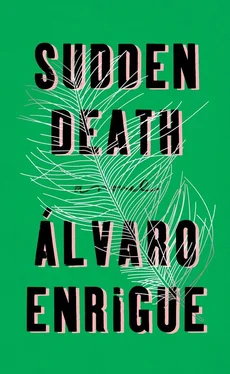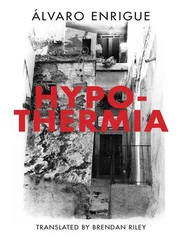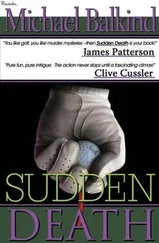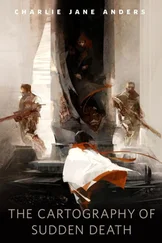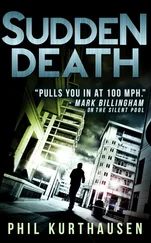The Calling of Saint Matthew has all of what would become the artist’s signature elements, and it was by far the most revolutionary work of art seen in a Roman place of worship since the inauguration of the Sistine Chapel. Caravaggio paid eloquent testament to Michelangelo’s fresco, which he knew well: the hand with which Jesus of Nazareth points to the tax collector quotes the one with which God almost touches the Son of Man in the upper reaches of the Vatican.
As in nearly all of Caravaggio’s subsequent sacred paintings, most of the surface of the Calling is empty, a dark room whose black walls — plainly those of his studio — are scarcely interrupted by a window with darkened panes. The single source of light isn’t visible in the painting: it’s a skylight, open just a crack above the actors’ heads. Peter and the Messiah, almost in shadow, point to the tax collector, who gazes at them in surprise in the company of four sumptuously dressed cronies busy counting coins with sinful concentration. The attire of Jesus and his fisherman is traditional: biblical robes. But the money changers look just like Giustiniani’s moneylenders and are sitting as they must have sat on the lower level of his palace, open to clients of the money-changing tables.
Caravaggio, who was not a modest man, must have announced — still seized by the fierce exhilaration of someone who’s solved a riddle — that what he was about to deliver was his best painting to date, better than Saint Catherine of Alexandria , accosting a sacristan in breeches with flattened hair. It must have been agreed that he would bring the painting at midday, when the full flock of French clergymen — and not just the half-addled old man who said the early mass — would be present in their beribboned finest.
Maybe it was the two youngest actors in the painting — Baldementi, the tattooist, and Sarzana, the arse-fanner — who hoisted up The Calling of Saint Matthew in the studio, crossed the courtyard, and, instead of going through the kitchen or scullery door as usual, carried it out by the main door, following the tyrannical instructions of a frenetic Caravaggio. Surely the rest of the actors in the painting were waiting outside, still dressed in character. The arse-fanner and the tattooist would have crossed the piazza, by now crammed with parishioners and tradesmen, to the cheers of those perhaps moved by the thought that what was happening was truly important — which it was, though they couldn’t have known it, since the future has no place in memory. The artist must have gone before them, parting the waters, puffed up with pride. Prospero Orsi, the soldier, was the uninhibited type, ill-equipped to resist fatuity and borrowed glory. Surely at some point in the crossing of the piazza he would have ordered his fellow actors to stop, and demanded that they stage the scene again in front of the painting itself.
The people at the doors of the church — the sacristan, the acolytes, the priests — must have watched the painting go by in as much of a fright as those seeing a movie projected on a wall for the first time, or with the slack-jawed fascination with which my son and I witnessed the early rollout of a high-definition television in an electronics store. The painting must have been propped against the altar as the carpenters prepared to mount it on the wall. The priests must have been uneasy — before they began to be vexed — at the presence of the boy they had so often seen wipe the shit from his little nose in the latrines of the house of the French Congregation, who was now inside the parish twice over, in the painting and in the flesh, and in banker’s attire. But this is only conjecture: specialists in the material culture of the seventeenth century continue to debate what exactly an asciugaculi did. Pay the gentleman so that they’ll leave, the cardinal of Sancy must have said nervously to the sacristan.

The duke put the ball on the chalk mark that the professor had made, in the first game, on the paving stones of the court after the ball’s first bounce off the post. The mathematician certified that it was the right spot and together they proceeded to ceremoniously take down the cord that divided the serving from the receiving court. They bundled it up and gave it to Mary Magdalene, who had requested it from the gallery. Then they took their places opposite where they had set the ball, outside the bounds of the court on either side. The mathematician stood there almost absentmindedly, his hands clasped behind his back. He was so calm that it was a miracle he didn’t whistle a Paduan ditty. The duke crouched opposite him, staring seriously at the ball and stroking his beard with his left hand. He exchanged looks with Barral, who put a frankly irresponsible quantity of coins on the line where bets were placed. The other gamblers found seats in the gallery after setting their money on the side of the player they thought would win the race for the serve. Opinions were divided for the first time in the match. Both seconds turned toward the players, who were standing together on the far side of the baseline and jostling shoulders, trying to knock each other off balance even before the start of the race. The duke deferred to the professor. Eccola! he shouted, and almost immediately: Gioco!
The start of the race might have been disastrous for the artist: his rival used his short leg to hook him by the ankle at the first stride. The trick worked, but the Italian managed to grab the Spaniard by the shirt and pull him down too. They tangled. Blows with the hands were forbidden by the rules, but they kneed each other as many times as they could in the process of freeing themselves.
The artist tried to roll over to make room to get up, but the poet was coiled like a spring, and from where he lay he hurled himself onto the Lombard’s back, squeezing his buttocks between his thighs and succeeding in holding him down. From this dominant position he rose, one knee planted in his opponent’s back at the height of the kidneys. He levered himself up with a hand flat on the artist’s head. Mary Magdalene covered her eyes when she saw how her lover’s skull bounced on the pavement. If not for the shouting, the crack would have been audible.
Alone on his feet, the poet rushed for the ball and managed to seize it. But he didn’t have time to run and put it in the dedans. The artist, one of his cheeks cut and bleeding, hurled himself full-force at the base of the poet’s spine, and both of them fell to the ground again. The Spaniard didn’t let go of the ball, but when he tried to get up, he felt the artist’s claw on his ankle, pulling him down. He went down again. The painter was on top of him, kneeling on his chest and trying to take the ball away.
Bites, elbow jabs, and clutches followed as both men rolled on the stones like children. At some point the poet ended up on his knees in front of the artist, the ball still firmly in his hand. The Lombard thrust his pelvis into his opponent’s face to block his view of the dedans and the Spaniard threw for it with all his soul. The ball went in. The duke cried: Service side.
The spectators returned to the gallery. The mathematician gathered up the coins that the Italians had set on the line. He counted them and crossed the field of battle to hand them over to Barral, who divided them among those who had bet on the Spaniard. He had to leap over the sprawled bodies of both contestants to reach the gallery.
The two players lay side by side, gauging the damage, unable to muster the strength to rise. They were on their backs. More scandalous than the quantity of bruises and scrapes on both was the fact that jutting from their codpieces were such generous erections that they seemed to lift them up. Delightful, said Mary Magdalene, imagining a luscious threesome with pinches, scrapes, and scabs.
Читать дальше
